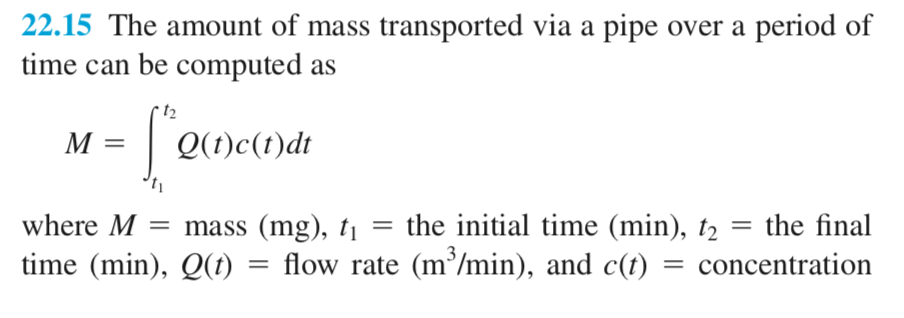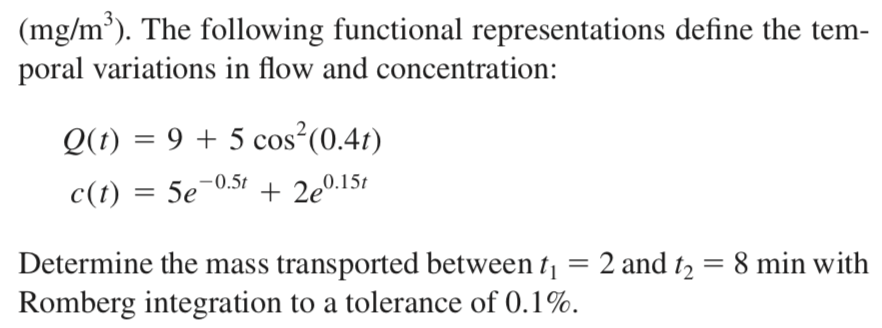Question
Class Code: %MATLAB % Romberg and Gauss Integration methods % function to integrate over [0,2] f = @(x) exp(x).*sin(x)./(1+x.^2); % make a plot first x



Class Code:
%MATLAB
% Romberg and Gauss Integration methods
% function to integrate over [0,2]
f = @(x) exp(x).*sin(x)./(1+x.^2);
% make a plot first
x = 0:0.01:2;
y = f(x);
plot(x,y);
% trapezoid rule estimate (what h needed to converge?)
% (there is no analytical solution...)
a = 0; b = 2; n = 2000;
I = trapezoid(f,a,b,n);
disp(['Trapezoid rule: ', num2str(n), ' fxn evals, estimate: ' num2str(I,
16)]);
% Built-in Matlab: Adaptive quadrature
[I, num_evals] = quad(f,a,b);
disp(['Built-in "quad": ', num2str(num_evals), ' fxn evals, estimate: '
num2str(I, 16)]);
% Romberg estimate
num_rows = 4;
R = romberg(f,a,b,num_rows);
disp(R) % show the whole table
I = R(1,num_rows+1); % the best integral estimate
num_evals = sum(2.^(1:num_rows+1));
disp(['Romberg: ', num2str(num_evals), ' fxn evals, estimate: ' num2str(I,
16)]);
% Gauss Quadrature estimates
disp(['Gauss 2-pt estimate: ' num2str(gauss2(f,a,b), 16)]);
disp(['Gauss 3-pt estimate: ' num2str(gauss3(f,a,b), 16)]);
disp(['Gauss 4-pt estimate: ' num2str(gauss4(f,a,b), 16)]);
% Functions used above: ~~~~~~~~~~~~~~~~~~~~~~~~~~~~~~~~~~~
% Trapezoid rule: function, a,b, number of segments
function I = trapezoid(f,a,b,n)
h = (b-a);
I = (h/2)*(f(a) + 2*sum(f(a+h:h:b-h)) + f(b));
end
% Romberg: function, a, b, number of rows in the table
% Follows Figure 22.4 of Chapra & Canale 7th Ed.
% Returns the full Romberg table, R
function R = romberg(f,a,b,num_rows)
R = zeros(num_rows, num_rows); % Romberg table
n = 1; % first step size: (b-a), one segment
R(1,1) = trapezoid(f,a,b,n); % first entry in table
% add a new row every iteration, and update columns
for iter = 1:num_rows
n = n*2; % every new row uses 2x the number of segments
R(iter+1,1) = trapezoid(f,a,b,n); % new row entry, bottom of first
column
% now that we've added a new row in column 1, update all other
% columns (one new value for each column)
for k = 2:iter+1
j = 2 + iter - k; % indexing hack to place the new value
R(j,k) = (4^(k-1) * R(j+1,k-1) - R(j,k-1)) / (4^(k-1) - 1);
end
end
end
% Gauss Quadrature (different functions for # of points)
% weights and x values from Table 22.1 of Chapra & Canale 7th
function I = gauss2(f,a,b)
c = [1 1]; % weight coefficients
x = [-1/sqrt(3) 1/sqrt(3)];
y = (a+b)/2 + (b-a)/2 * x;
I = (b-a)/2 * sum(c.*f(y));
end
function I = gauss3(f,a,b)
c = [0.5555556 0.8888889 0.5555556]; % weight coefficients
x = [-0.774596669 0 0.774596669];
y = (a+b)/2 + (b-a)/2 * x;
I = (b-a)/2 * sum(c.*f(y));
end
function I = gauss4(f,a,b)
c = [0.3478548 0.6521452 0.6521452 0.3478548]; % weight coefficients
x = [-0.861136312 -0.339981044 0.339981044 0.861136312];
y = (a+b)/2 + (b-a)/2 * x;
I = (b-a)/2 * sum(c.*f(y));
end
22.15 The amount of mass transported via a pipe over a period of time can be computed as t2 where M - mass (mg), ti - the initial time (min), t2 - the final time (min), Q) flow rate (m/min), and c)concentration Note: The problem asks you to perform Romberg integration to a tolerance of 0.1%. This refers to the % change in the integral estimate between iterations (ie, each time you add a new row to the Romberg table). You will need to modify the class code to implement a stopping condition based on tolerance, which we did not do in classStep by Step Solution
There are 3 Steps involved in it
Step: 1

Get Instant Access to Expert-Tailored Solutions
See step-by-step solutions with expert insights and AI powered tools for academic success
Step: 2

Step: 3

Ace Your Homework with AI
Get the answers you need in no time with our AI-driven, step-by-step assistance
Get Started


